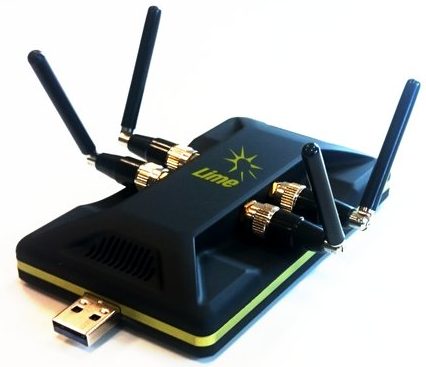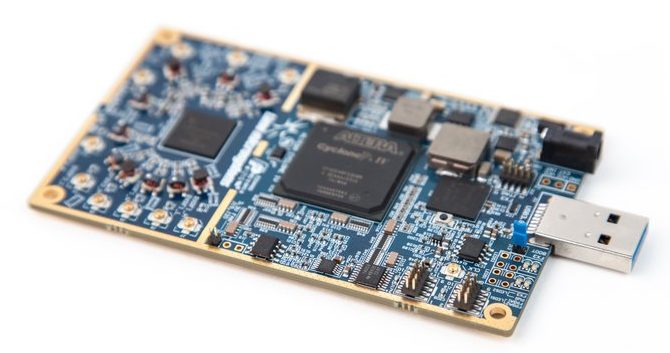There’s a new SDR under development–one that is promoted as a “Flexible, Next-generation, Open Source Software Defined Radio.”
The LimeSDR‘s goal, essentially, is to democratize what I call the “RF of things.”
My friend, Bernie S, told me about the LimeSDR a couple months ago and I’ve been following progress since then. It’s a fascinating concept and one that is being supported by the likes of Canonical Ltd.
Earlier today, LimeSDR launched a crowdfunding campaign on CrowdSupply. If early activity is any indication, I expect the team will easily exceed their goal of $500,000 (already 10% funded at time of posting).
Here’s information from LimeSDR’s CrowdSupply page:
A Software Defined Radio for Everyone
LimeSDR is a low cost, open source, apps-enabled (more on that later) software defined radio (SDR) platform that can be used to support just about any type of wireless communication standard, including UMTS, LTE, GSM, LoRa, Bluetooth, Zigbee, RFID, and Digital Broadcasting, to name but a few.
While most SDRs have remained the domain of RF and protocol experts, LimeSDR is usable by anyone familiar with the idea of an app store – LimeSDR is the first SDR to integrate with Snappy Ubuntu Core. This means you can easily download new LimeSDR apps from developers around the world. If you’re a developer yourself, then you can share and/or sell your LimeSDR apps through Snappy Ubuntu Core as well.
The LimeSDR platform gives students, inventors, and developers an intelligent and flexible device for manipulating wireless signals, so they can learn, experiment, and develop with freedom from limited functionality and proprietary devices.
From Radio Astronomy to Personal Telcos
Here are just some of the applications that are possible with the LimeSDR:
- Radio astronomy
- RADAR
- 2G to 4G cellular basestation
- Media streaming
- IoT gateway
- HAM radio
- Wireless keyboard and mice emulation and detection
- Tire pressure monitoring systems
- Aviation transponders
- Utility meters
- Drone command and control
- Test and measurement
- Many more…
With state-of-the-art technical specs, a fully open hardware and toolchain, and integration with Snappy Ubuntu Core’s app distribution platform, LimeSDR is limited only by our collective imagination.
Features & Specifications
- RF Transceiver: Lime Microsystems LMS7002M MIMO FPRF (Datasheet)
- FPGA: Altera Cyclone IV EP4CE40F23 – also compatible with EP4CE30F23
- Memory: 256 MBytes DDR2 SDRAM
- USB 3.0 controller: Cypress USB 3.0 CYUSB3014-BZXC
- Oscillator: Rakon RPT7050A @30.72MHz (Datasheet)
- Continuous frequency range: 100 kHz – 3.8 GHz
- Bandwidth: 61.44 MHz
- RF connection: 10 U.FL connectors (6 RX, 4 TX)
- Power Output (CW): up to 10 dBm
- Multiplexing: 2×2 MIMO
- Power: micro USB connector or optional external power supply
- Status indicators: programmable LEDs
- Dimensions: 100 mm x 60 mm
Bernie has encouraged me to evaluate the LimeSDR. I may very well attempt to do so, but frankly, I don’t have the experience to truly unlock this device. I am curious if it would make for an amazingly useful little all-in-one HF/VHF/UHF digital decoding device. In fact, I’m pretty sure it would be an easy task for the LimeSDR.
Any Post readers out there plan to back the LimeSDR project? If so, please comment and tell us how you plan to use the LimeSDR.



I would be interested in a receive only version with a non-phone based display and user interface. On top of that it would need to be standalone not tethered to PC, phone or internet to be used. of course it could be connected via USB to download changes and updates via download.
A device that allows anyone with the money and programming skills to transmit on any frequency from 50 MHz up to the cellular bands? What could *possibly* go wrong?
That’s awfully tempting. I’m not sure what I’d use it for yet, but I have a few ideas – including an easy trunking capable scanner. My thoughts for it as an all-band transceiver might not work for the HF bands if the below snippet from the docs are accurate.
>Single chip dual transceiver. The LMS7002M is 3GPP compliant and supports all cellular standards and frequencies including TDD, FDD and MIMO. The highly integrated device features multiple 12 bit ADC and DACs, LNAs, filters and mixers to provide two transmit and receive paths for continuous coverage over the 50 MHz to 3.8 GHz range.